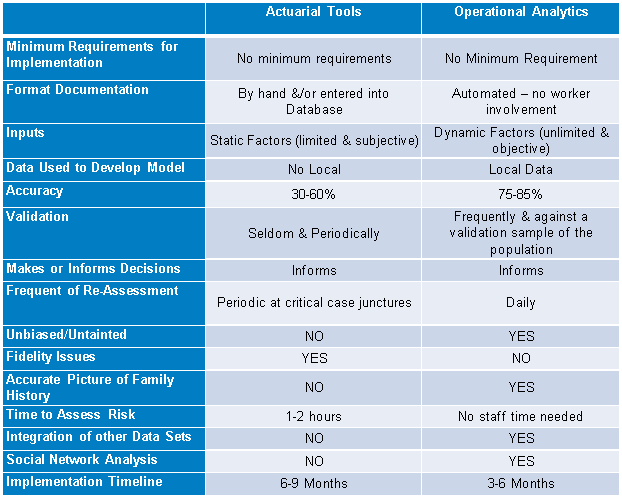As state and local government leaders and community advocates explore how predictive analytics can improve child well-being outcomes, many questions and potential concerns surface.
It is critical to understand that government youth services agencies across the United States have used actuarial Risk & Need Assessment tools for many years. Many of these were developed using predictive analytics to identify “static” risk factors, such as low birth weight and mother was previously in foster care, that contribute to risk of maltreatment.
While these tools are a good starting point, there face implementation problems such as accuracy requirements, worker bias, amount of time to complete, etc. With an operational analytic approach, analytics is continually assessing and reassessing data, making the system smarter. Ongoing assessment of risk and needs allows for both static and dynamic factors to be used when calculating risk of maltreatment. This supports increased accuracy, real time risk scoring, limited worker bias, etc.
Below is a comparison/contrast of actuarial tools vs. and operational analytic solution such as SAS for Child Safety:
I worked in child well-being for 22 years, and have met with countless leaders and community advocates to discuss advance analytic approaches and their applicability to human services. Several concerns have been raised consistently that can be addressed with data driven and research based responses. These include:
- False Positives
- Racial Bias/Disparity
- Equation vs. Comprehensive Process
- Current Tools are Sufficient
In my next posts, I will dive deeper into these concerns as well as findings from my peers in SAS Solutions on Demand, who are engaged in pioneering work on child welfare analytics. I will explain why leaders and child well-being advocates can feel confident in predictive analytics, and its ability to help kids and ease the burden on caseworkers.
Do you have concerns beyond these, or heard of others? Please share in the comments.


6 Comments
As quoted in the Washington Post management guru Edwards Deming said "without data you or another person with an opinion ". And I would add just make sure your data is sound and accurate. SAS, BMD, BMDP, SAS remain great tools for individuals who wish to be a bit more certain in their opinions. Even then, decision makers presented with sound and accurate date must have the final say. Just hope the final decision can be backed up with facts - or politics; as you know! Thanks for listening to my rant!
Glen, thank you for taking the time to comment. It is always nice to enhance the conversation around improved outcomes for kids. The purpose of using advanced analytics is to actually increase the accuracy of current risk and needs assessment tools and help improved informed decision making by staff who have historically used their "gut". The analytics are to augment institutional knowledge that exists. One of the major problems that exists today is the lack of institutional knowledge due to high turnover rates and short tenures of the workforce.
Thanks again for sharing.
Given your juvenile justice background, Mr. Jones, this is not news to you. But other readers of your blog may not be aware that many state juvenile justice systems are struggling with weak instruments for assessing risk of recidivism, and few of these have been validated on the population to which they are applied. Further, the practice of combining assessments of risk and treatment needs in the same instrument has complicated matters. Tools proffered in many states for assessing treatment needs are ill-suited for this purpose, often measuring psychological problems and a large number of protective factors that cannot easily be addressed. As a result of these complications, many state juvenile justice systems are overwhelmed with unmanageable risk or treatment need assessment instruments that are misused, require excessive amounts of staff time to complete, and often produce a mound of data that program administrators and supervisors do not have the staff capacity to analyze nor put to good use in everyday practice.
Exactly. This is why using operational analytics, in addition to current risk and needs assessment tools, will help improve the accuracy of assessment, which will help inform appropriate placement and service options. Unfortunately, the majority of JJ systems continue to lean on actuarial tools despite the fact that the tool developers themselves understand the limitations of static factors. Thanks for sharing your thoughts and insights Buddy.
Pingback: Tackling 4 common concerns about analytics for child well-being - State and Local Connection
Pingback: Tackling 4 common concerns about analytics for child well-being - State and Local Connection